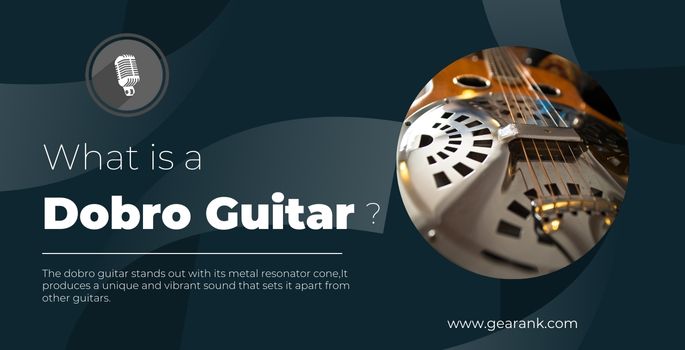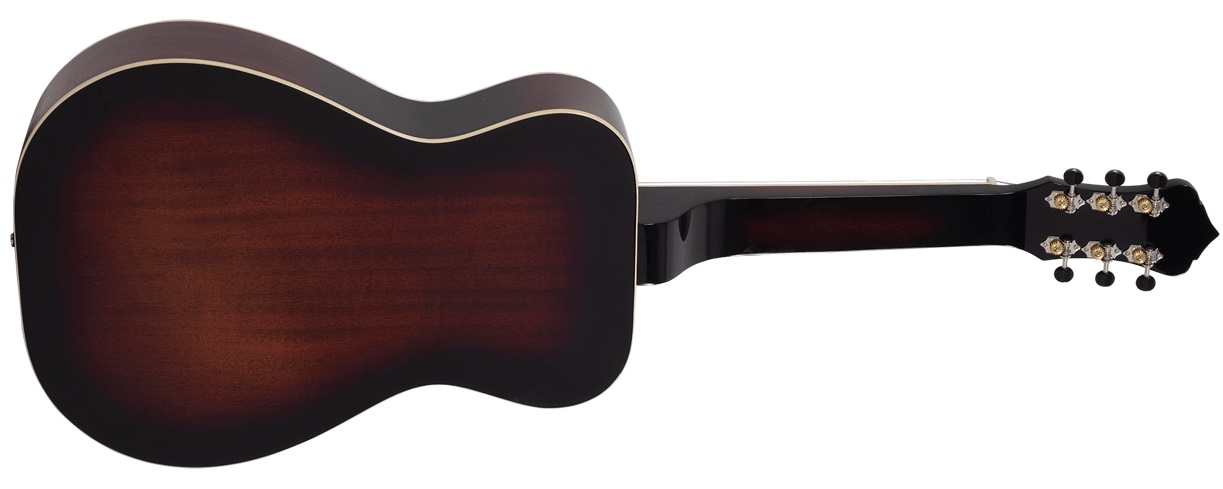
We’re familiar with the two popular guitar types, acoustic and electric guitars. But lesser-known varieties, like the Dobro, deserve closer attention.
So, what is a dobro guitar, and what makes it a unique instrument?
We will go over this peculiar musical instrument and look at its distinctive sound, which helped shape its legacy in music.
What Is A Dobro Guitar?
The Dobro guitar is part of the resonator guitar group. It looks similar to an acoustic guitar but with a glaring difference, a huge metallic cone on the sound board.
This resonator cone amplifies the sound and gives the Dobro its gnarly metallic tone. And this tone is what differentiates it from other types.

Replacing the traditional soundhole is a resonator cone, which amplifies the sound and changes the voicing.
The metal resonator cone makes it sound substantially louder than regular acoustic guitars. It also produces a recognizable tone well suited for delta blues music, country music, bluegrass, folk, and similar musical styles.
Dobro guitars have a square neck and high-action setup. The chunky neck and the ridiculously high action make it impossible to play like a regular guitar. Dobros are played lap style, using a heavy steel bar.
There are resonator (sometimes called resophonic) guitars that have round necks. They are sometimes called the round neck dobro. They play like a regular acoustic guitar, with string action that can be fretted. These are often played with glass slides in a conventional guitar-playing posture.
A History Of Dobro
The square neck Dobro guitar was invented in 1928 by two Slovakian brothers, John and Rudy Dopyera.
The Dopyera brothers designed it to have a squared-off neck, raised strings, and a distinct resonator. They wanted a louder guitar with a brighter tone and signature sound.
It was the third resonator guitar that the brothers had created. In earlier designs, the first resonator guitar had three inward-facing resonator cones, but the Dobro had one outward-facing cone, with a concave surface facing upwards. This was then referred to as a bowl-shaped resonator guitar.
John Dopyera left the National String Instrument Corporation and founded the Dobro Manufacturing Company. But John Dopyera remained a stakeholder in National.
The National and Dobro corporations built tri-cone resonators and single-cone versions (respectively) for many years. The brothers eventually merged the companies to make the National Dobro Corporation and continued to sell guitars until World War II.
The Dobro was first invented in Hawaiian music but has become a popular instrument for blues, bluegrass, and country music. Nowadays, dobros are used in rock or even jazz music, too.
Today, the Dobro guitar is a Gibson subsidiary. Gibson acquired the Dobro brand name and currently has the most stakes in it.
Features of Dobro & Resonator Guitars
Dobro and resonator guitars often have wooden bodies paired with an aluminum resonator. This combination gives it its metallic tone and loud projection.
There are also models with full metal bodies, which results in even more pronounced metallic overtones. And dobros with different metal materials have their distinctive sound.

They also have longer necks than acoustic guitars, and the body is slightly smaller than a standard acoustic.
The headstock will be mounted to the neck, with a bridge and tailpiece made of metal. The strings run through the bridge but over the cone- which often resembles spider legs in appearance.
Roundneck resonators are more forgiving to the fretting hand, allowing for strumming and finger picking. But a square neck dobro will require thumb picks and finger picks.
The most notable difference with resonator instruments is that the sound hole is different. They do not have traditional round sound holes. In its place is a large, round, perforated plate cover (also called a hub cap) with a bridge built in for more amplified string vibrations.

They may also have two additional sound holes near the fingerboard’s edge. These can sometimes be f-style holes, which are becoming increasingly popular.
Today, plenty of affordable dobro guitars and the usual premium options from well-established brands exist.
What Is The Difference Between A Dobro And A Lap Steel Guitar?
Lap steel guitars and resonators or Dobro guitars are often considered the same. But there are important distinctions.
One is that a lap steel guitar is primarily an electric guitar. It uses magnetic pickups to get their sound amplified. This means clearer sound with more sustain.

Lap steel guitars have a different overall tone to the Dobro. It is far less bright and can be a little distorted. But it is also considered an instrument easier to play than regular dobro guitars.
In comparison, the Dobro has a lot of volume and crisp high-end. Volume is adjusted chiefly by how hard you are hitting the strings. But the Dobro is a bit more challenging to play.
Is A Dobro The Same As A Resonator Guitar?
Dobro is technically a brand name under Gibson Guitar Corporation. So, not all resonator guitars are from the Dobro brand.
But it has become so popular that it became the label for an entire family of guitars.
Nowadays, the terms resonator and Dobro are often used interchangeably.

Is Dobro Harder To Play Than Guitar?
The short answer is yes, it is more challenging. Compared to regular guitars, the Dobro is a type of guitar requiring advanced skills.
Using slides is not beginner-friendly. Even more so for a square neck dobro that has to be played lap style.
Open tuning also means you have to go outside the comfortable standard tuning. You’ll have to unlearn standard chord shapes and scales and learn to play in open tunings like Open G.
Summary
So, what is a Dobro? Dobro started as a brand of resonator guitars. It has a metal resonator cone that gives it its distinct voice.
Over time, “Dobro” became the common term for all resonator guitars within the family.
Dobros refers to square neck models for lap-style slide playing and steel bars. But some round-neck models can be played like a regular acoustic.
So what are you waiting for? Get your hands on a resonator guitar. Learn to play slide on Open G tuning, and start playing single notes like the 13-time Grammy winner Jerry Douglas.






I have a tin ear, so should I stay away from fretless instruments.
Thank you, Raymond L Ingram